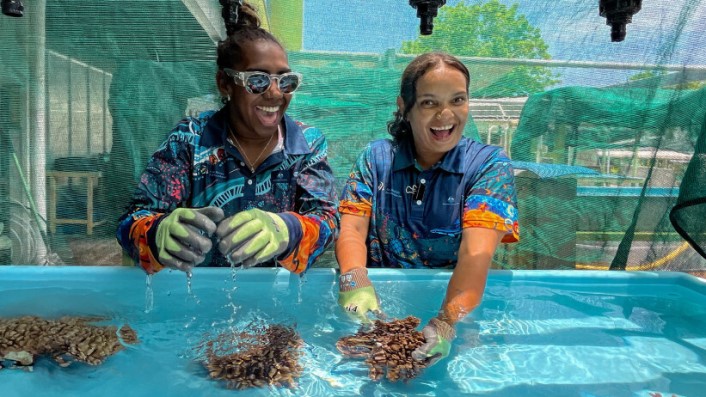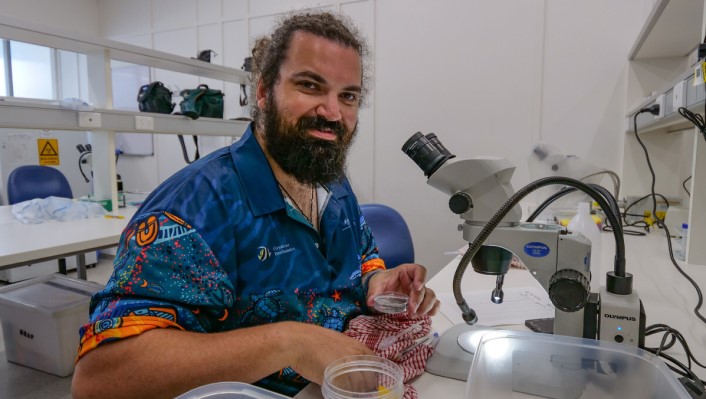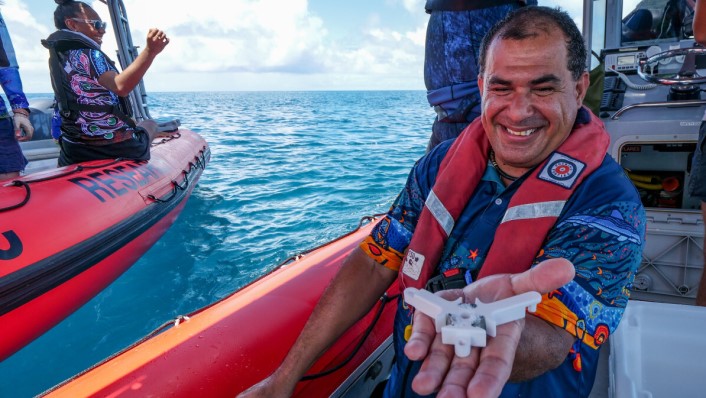Researchers from the Australian Institute of Marine Science (AIMS) are partnering with Traditional Owners and Indigenous Rangers in a new project which aims to expand the delivery of coral larval restoration interventions to the Great Barrier Reef.
Indigenous Rangers from six Traditional Owner groups, Indigenous researchers, interns and trainees gathered with AIMS scientists and support staff on Heron Island in the southern region of the Reef to build skills across different coral larval restoration approaches during the recent annual mass coral spawning event - a key time of reproduction and recovery on the Reef.
The pilot training scheme is part of the Indigenous Futures project, which aims to empower Traditional Owners to lead in caring for sea Country, by ensuring they are the first to learn about new ways to best help the Reef, and to upscale these interventions on their own sea Country.

AIMS Indigenous Training and Capacity Building Officer Jordan Ivey said helping the Reef under a warming climate at scale would require not just science, but partnership with Indigenous Rangers, Traditional Owners, industry and managers.
"Traditional Owners hold important cultural and spiritual connections to Country, including sea Country on the Great Barrier Reef. These connections power deep knowledge and care for the Reef, and inherent rights and responsibility for its future. It is only natural they play a key role in the delivery of the interventions AIMS scientists and their collaborators are developing across the Reef," he said.
"Scaling up a suite of coral larval restoration approaches will be key to positive outcomes on the Reef - a system the size of Italy.
"It has been a learning experience for us all on Heron Island, but we have laid some important foundational knowledge and expanded on the existing skills of Indigenous Rangers to support Traditional Owner-led intervention activities in the future.
"We are training this cohort so they can translate their new and enhanced skillset out to their ranger organisations to implement in the future."

Alongside collaborators, AIMS coral reproduction and aquaculture scientist Dr Muhammad Azmi Abdul Wahab was among those delivering training on Heron Island, including:
- the collection and rearing of coral larvae following spawning;
- the establishment of an island-based coral aquaculture system;
- the deployment of young corals on seeding devices on the Reef, and;
- the monitoring of young corals over time to determine success.
Dr Abdul Wahab said: "Coral spawning is a crucial time on the Great Barrier Reef, especially because this year's event came after the summer's serious and extensive mass coral bleaching and two cyclones which caused coral cover losses in some parts of the Reef.
"It has been inspiring to share learnings and experiences with these engaged and passionate Indigenous Rangers and Traditional Owners, all of whom are contributing to the continuous improvement of the new methods coming out of our research, and their delivery.
"The toolbox of interventions we are working on can help the Reef, alongside reducing emissions globally. This is fundamental to securing the best future for reefs, which are threatened by climate change."
Two-way learning
Kelvin Rowe, a Gidarjil Ranger Coordinator and Traditional Owner of the Port Curtis Coral Coast said he enjoyed working with the AIMS researchers because of the two-way learning opportunities.
"Our ranger groups have been working together, wanting to learn and asking questions to learn so we can show everybody in our own communities. AIMS has given us a huge opportunity, especially on the learning side, making it hands on, which is good," he said.
"They have been willing to learn from us too, about our cultural ways, how we connect to the ocean, even to areas that we now own, even for our own stories. Many of us here are all from different places but we are all connected to one part of the Reef."
Tshinta Barney, Woppaburra Land and Sea Ranger said her experience on Heron Island had opened her eyes to the complexities of reef restoration.
"It's astounding. When you see it up close like we have, you realise that a lot of work goes into this," she said.
"The Woppaburra people have been working with AIMS scientists around the Keppels . This made me feel more comfortable to come here and work with them. They're hoping that we can take some of this knowledge back and help to restore some more of the reef there."

Great Barrier Reef Foundation Managing Director Anna Marsden said: "Australia's Traditional Owners are the first scientists, farmers, engineers, innovators and conservationists. They have successfully nurtured and protected their environment through changing seasons and climates, guided by Traditional Knowledge and customs passed down through generations.
"The Great Barrier Reef Foundation is proud to co-design impactful projects such as this that weave this knowledge with western science to help overcome a key challenge to protecting our Reef - scaling reef restoration efforts."
The three-year Indigenous Futures project began in 2023 and includes formal accreditation units for participants within the Certificate III in Conservation and Ecosystem Management.
The Indigenous Futures project is supported by AIMS, the Australian Government's Reef Trust through the Reef Trust Partnership with the Great Barrier Reef Foundation, and the Reef Restoration and Adaptation Program.






